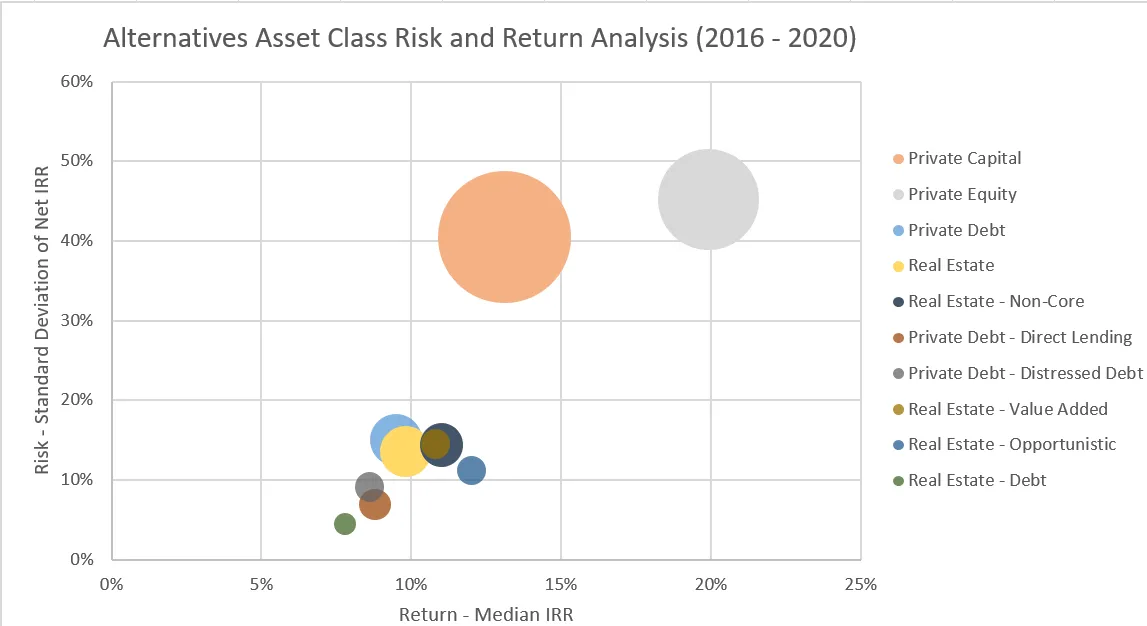Real Estate and Private Credit Investing
With the proliferation of private investment opportunities, investors are now presented with a multitude of different options for generating competitive returns relative to what can be earned in the public markets. Yet two markets in particular have seen sizable growth while garnering significant attention from investors, even despite the current COVID-19 pandemic: real estate and private credit.
Federal stimulus to offset the impact of the pandemic — along with regulatory changes following the Global Financial Crisis — resulted in the growth of non-bank participation in these markets as well as a depressed interest-rate environment. This has increased the appeal of these cash-generating, high-yield investment strategies that subsequently resulted in significant increases in allocation to both asset classes. Beyond rising investor attention, both real estate and private credit exhibit similar characteristics at a high level that are worth exploring for any investor interested in diversifying beyond traditional equities.
Below, Percent’s Capital Markets team highlights the role of real estate and private credit in investors’ portfolios, the key comparable characteristics illustrated by both, and how these may be accessed to fit individual investment strategies.
PRIVATE VS. PUBLIC MARKETS
Private markets continue to play a critical role in investors’ portfolios. Over a three-, five-, and ten-year period, private capital markets have outperformed both the public and real estate markets (inclusive of debt and equity strategies). These alternative investments generally provide investors with uncorrelated returns. While credit risk and illiquidity are important considerations and are often associated with private capital, historical return profiles highlight the collective value these asset classes can provide to investors. The table below illustrates the return profile of three core investment areas that are broadly uncorrelated and allow investors to diversify underlying portfolio concentration.
Asset Class13 Year Return5 Year Return10 Year ReturnPrivate Capital14.1%13.7%13.2%Public Markets12.4%12.4%11.2%RE/CRE5.0%6.3%10.0%
Source: Preqin Pro, The National Council of Real Estate Fiduciaries (NCREIF), Wellington Balanced Composite Index
PRIVATE CAPITAL MARKETS PERFORMANCE

Source: Preqin Pro
Note that the size of the circles above corresponds to its market size. Private Debt is inclusive of direct lending, mezzanine financing, distressed debt, special situations, and venture funds.
Between 2016-2020, private capital markets have averaged a 13.1% median IRR. Hovering around high single-digit returns is private credit investing, with the category at large as well as its subcategories (direct lending and distressed debt) generating a median IRR of approximately 9.0%. At a slight notch higher, real estate investing at large has garnered 9.8% median IRR, while Non-Core, Value Added, and Opportunistic Real Estate have achieved median returns of 11.0%, 10.8%, and 12.0%, respectively.
Note the similarity in risk profiles as defined by standard deviation of IRR and corresponding performance of both real estate and private credit. These immediate similarities and others warrant further analysis around when each is appropriate in an investor’s portfolio.
REAL ESTATE VS. PRIVATE CREDIT
CategoryPrivate Credit2Real Estate32020 U.S. Market Size$848Bn$1.9Tn5 Yr CAGR411.9%4.8%Default Rate - 1Yr (as of 2020)3.83%0.97%Default Rate - 3Yr (as of 2020)2.28%0.79%Default Rate - 5Yr (as of 2020)2.10%0.81%
As exhibited in the preceding tables, private credit and real estate represent broad categories that can be invested in in various ways and across the credit spectrum and different economic sectors, and therefore represent a wide range of investment opportunities. Private credit investments include direct corporate lending, distressed debt, infrastructure investments, among others. Real estate investments can be structured as either debt or equity strategies across a variety of sub-asset classes, including retail and commercial properties, real estate investment trusts (REITS), commercial mortgage backed securities, collateralized debt obligations, among others. However, this analysis focuses primarily on real estate credit strategies as a direct comparable to alternative private credit and asset-based opportunities more generally.
Both private credit and real estate debt strategies exhibit several characteristics that equilibrate the two categories:
- First, as cash-yielding investments, investors seeking income can look to both asset classes for predictable, stable income.
- Second, private credit and real estate are both sensitive to interest rate, repayment, and default risk. The 1Yr, 3Yr, and 5Yr default rates for real estate were all <1% each, and while the data infrastructure is still being built out for the private credit market at large, rates vary drastically by sub-category, though investors are able to compare default rates between the two sectors.
- Generally, investors seek private capital and real estate for their longer investment horizons, though real estate generally has a slightly longer investment timeframe
POSITIONING PERCENT
Given these core similarities and comparable cash flow generation, we believe that real estate debt investments are a strong complement to private credit investments, offering asset-based principal protection, scalability, and diverse sub-strategies to generate capital growth across the risk-return spectrum.
Percent is a leading alternative investment platform that connects specialty finance originators with its significant investor base, and each transaction offered is the result of its robust due diligence and risk management capabilities. As of September 2021, Percent’s issuance volume totalled over $550M across a variety of private capital industries: small-business loans, factors receivable, litigation financing, app development financing, and healthcare financing, among others. Percent’s approach and methodology allows for a thorough and consistent review of each additional industry added to our platform.
As Percent continues to increase its reach across different credit opportunities and asset classes, our belief is that real estate represents a compelling vertical and investment area for our highly-engaged platform investors. These issuances will offer the same rigorous due diligence and underwriting featured across our current and historical issuances, while providing diversified exposure to a leading global category and its different sub-categories.
Given the ongoing search for yield, secular growth in alternative investments, and demand for income-generating opportunities, we invite you to join our member community by signing up for a free account to explore our current opportunities and keep up to date on future real estate debt offerings.
Disclaimers:
This material is provided for informational purposes only and is not intended as and may not be relied on in any manner as legal, tax or investment advice, a recommendation, or as an offer to sell, a solicitation of an offer to purchase or a recommendation of any interest in any unsecured note or security offered by Cadence Group Inc. (DBA Percent Technologies) or its affiliates (together “Percent”). Alternative investments are complex, highly speculative and are not suitable for all investors. This material does not intend to address the financial objectives, situation or specific needs of any individual investor. The information contained herein is subject to change and is also incomplete. This information and its importance are an opinion only and should not be relied upon as the only important information available. Information contained herein has been obtained from sources believed to be reliable, but not guaranteed, and Percent assumes no liability for the information provided.
Products offered by Percent are typically private placements that are sold only to Accredited Investors of Percent through transactions that are exempt from registration under the Securities Act of 1933 pursuant to Rule 506(b) or Rule 506(c) of Regulation D promulgated thereunder (“Private Placements”). An investment in any product issued pursuant to a Private Placement entails a high degree of risk and no assurance can be given that an investment will be profitable or that an investor will receive a return of their capital. Further, such investments are not subject to the same levels of regulatory scrutiny as publicly listed investments, and as a result, investors may have access to significantly less information than they can access with respect to publicly listed investments. Prospective investors should also note that investments in the products described herein are restricted securities and do not provide investors with liquidity. Therefore, an investment in a Private Placement should be made only if the investor can assume the risks of an illiquid investment.
Securities may be offered through GT Securities, LLC, a registered broker dealer, member of FINRA and SIPC. These registrations and memberships in no way imply that the SEC, FINRA or SIPC have endorsed the entities, products or services discussed herein. Percent and Percent Technologies are registered trademarks of Cadence Group, Inc. Additional information is available upon request.
1As of 12/31/20.
2 Source: S&P Global Market Intelligence. Leveraged Commentary & Data Weekly Wrap 2016-2020. Leveraged loans were used as a proxy for private credit.
3 Real Estate as defined as commercial real estate. Source: Delinquency Rate on Commercial Real Estate Loans, Federal Reserve Economic Data
4 From 2015-2019.





